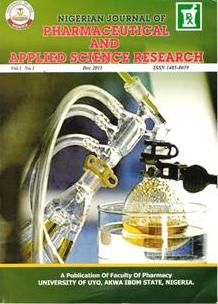Pharmacognostic studies of leaf of Craterosiphon scandens Engl. & Gilg. (THYMELAEACEAE)
Main Article Content
Abstract
Background: Craterosiphon scandens Engl. and Gilg. (Thymelaeaceae), commonly known as african winged bean, bierie, or Itaka in various African region has been traditionally used for various medicinal purposes such as stomachache, malaria and fever. This study is aimed at identifying, describing and documenting the pharmacognostic, and diagnostic characters to establish standardization and quality control parameters for the leaves of C. scandens.
Methods: Standard procedures were used for microscopy, micrometry, chemomicroscopy, moisture content, ash values, extractive values, fluorescence, and physicochemical properties.
Results: The results of the leaf microscopy revealed that the epidermal cell wall was iregular for both abaxial and adaxial surface, with hypostomatic stomata, and anticlinal wall pattern as straight-undulate. For the micromeritic evaluation of the powdered leaf, the Hausner ratio was 1.546 and Carr’s index was 36, indicating poor flow, the angle of repose was 42.520 indicating a passable flow. Chemo microscopy study revealed the presence of mucilage, cellulose, lignin, starch and calcium oxalate crystals (druse) while protein was absent. The moisture content of the leaf was 9.5% w/w, the total ash value was 8.6% w/w, the acid-insoluble ash value was 1.7% w/w, the water-soluble ash value was 1.8% w/w. The water-soluble extractive values, ethanol- soluble values and methanol-soluble values for the leaf of C. scandens were 16.67% w/w, 12.33 % w/w and 13.67% w/w respectively, all these falls within the limit when compared to the standard.
Conclusion: These findings support the identification and authentication of C. scandens, establishing standards for quality, purity, safety, and efficacy in Herbal medicine.
Downloads
Article Details

This work is licensed under a Creative Commons Attribution-NonCommercial-NoDerivatives 4.0 International License.
References
.Angiosperm Phylogeny Group. An update of the Angiosperm Phylogeny Group classification for the orders and families of flowering plants: APG IV. Bot J Linn Soc. 2016;181(1):1-20.
.Johnny II, Umoh UF, Umoh RA, Alozie MF, Udobre AS, Igboasoiyi AC, Bassey ME, Andy NA, Udo IJ, Umoh OT. Pharmacognostic characterization of Cola millenii K. Schum. (Malvaceae). Asian J Biol. 2022;14(1):6-24.
.Metcalfe CR, Chalk L. Anatomy of the Dicotyledons. Vol 1. Oxford: Clarendon Press; 1979. p. 279.
.African pharmacopoeia. General method of analysis of pharmacopoeia. Lagos: Organization of African Unity, Scientific Technical and Research Commission; 1986. p. 121-208.
.Mbah CC, Builders PF, Akuodor GC, Kunle OO. Pharmaceutical characterization of Bridelia ferruginea Benth. (Euphorbiaceae). Trop J Pharm Res. 2012;11(4):637-44.
.Kokate CK, Purohit AP, Gokhale SB. Pharmacognosy. 4th ed. Pune: Nirali Prakashan; 2003. p. 109-23.
.Kokoski CJ, Kokoski RJ, Slama FJ. Fluorescence of powdered vegetable drugs with particular reference to the development of ultraviolet light radiation. J Am Pharm Assoc. 1958; 38:715-9.
.Kumar D, Gupta J, Kumar S, Arya R, Kumar T, Gupta G. Pharmacognostic evaluation of Cayratia trifolia (Linn.) leaf. Asian Pac J Trop Biomed. 2012;2(1):6-10.
.Rahmatullah M, Ferdausi D, Mollik MAH, Jahan R, Chowdhury MH, Haque WM. A survey of medicinal plants used by Kavirajes of Chalna area, Khulna District, Bangladesh. Afr J Tradit Complement Altern Med. 2010;7(2):91-7.
.Walter L. The pharmaceutical codex: Principles and practice of pharmaceutics. 12th ed. London: Pharmaceutical Press; 2009. p. 184-5.
.European Pharmacopoeia. Pharmacopoeia limits of crude drugs. Strasbourg: Council of Europe; 2007. p. 124-64.
.Abere AT, Onwukaeme ND. Pharmacognostic evaluation of the leaves of Secamone afzelii (Schult) K. Schum (Asclepiadaceae). Trop J Pharm Res. 2012;11(1):125-31.


